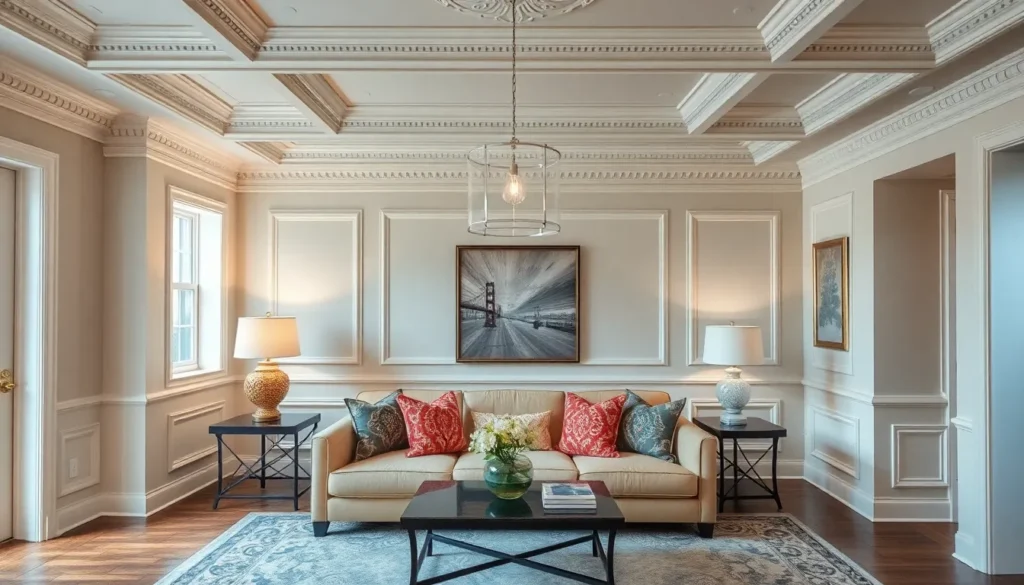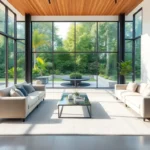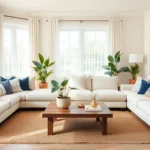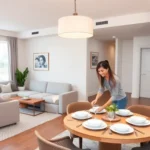Wall trim transforms ordinary rooms into extraordinary spaces with just a few strategic additions. We’ve all walked into a room and felt something was missing – that polished finish that separates amateur DIY from professional interior design. The secret often lies in the details, and wall trim delivers that missing piece with remarkable impact.
Whether you’re dealing with builder-grade walls that need character or outdated spaces crying out for a refresh, the right trim can elevate your home’s aesthetic without breaking the budget. From classic crown molding that adds elegance to modern geometric patterns that create visual interest, wall trim offers endless possibilities for personalization.
We’ll explore creative trim ideas that work for every style and skill level, helping you discover how these architectural elements can define spaces, hide imperfections, and add value to your home. Get ready to transform your walls from bland to grand with these inspiring trim answers.
Classic Crown Molding Ideas for Elegant Sophistication
Crown molding remains the pinnacle of architectural elegance, transforming ordinary ceilings into sophisticated design statements. We’ve curated the most impactful crown molding approaches to elevate your wall trim project.
Traditional Ornate Crown Molding
Traditional ornate crown molding features intricate details like dentil blocks, egg and dart patterns, and acanthus leaf carvings that create stunning visual impact. We recommend installing 4-6 inch profiles in formal dining rooms and living spaces where grandeur takes center stage. Popular materials include solid wood species like oak, cherry, and maple that showcase fine craftsmanship through their natural grain patterns.
Consider these classic ornate elements:
- Dentil molding creates rhythmic rectangular blocks that cast beautiful shadows
- Cove molding offers gentle curved transitions between walls and ceilings
- Rope molding adds twisted rope textures for nautical or colonial themes
- Fluted details provide vertical grooves that enhance architectural depth
Installation requires precise miter cuts and coping techniques to achieve seamless corners that highlight the molding’s elaborate profile.
Simple Modern Crown Molding
Simple modern crown molding embraces clean lines and minimal profiles that complement contemporary interior design. We prefer 2-4 inch smooth profiles made from MDF or flexible polyurethane that create subtle definition without overwhelming modern aesthetics. These streamlined designs work exceptionally well in open floor plans where consistent trim profiles unify connected spaces.
Key characteristics of modern crown molding include:
- Flat profiles without decorative elements maintain clean appearances
- Stepped designs create geometric interest through layered planes
- Cove curves offer gentle transitions in minimalist applications
- Square edges provide sharp definition for ultra modern spaces
Paint these profiles in crisp white or match your wall color for seamless integration that enhances architectural flow.
Layered Crown Molding Designs
Layered crown molding combines multiple trim pieces to create custom profiles with enhanced visual weight and sophistication. We achieve dramatic results by stacking base molding, quarter round, and crown pieces in strategic configurations. This technique allows you to create expensive looking architectural details using readily available lumber yard materials.
Effective layering strategies include:
- Base and crown combinations create substantial 6-8 inch profiles
- Picture rail additions provide horizontal lines that break up wall height
- Chair rail integration connects upper crown elements to lower wall sections
- Rope accent layers add textural contrast between smooth profile elements
Start with your largest piece as the foundation, then add smaller complementary profiles to build impressive custom looks that rival expensive millwork installations.
Wainscoting Wall Trim Ideas for Timeless Appeal
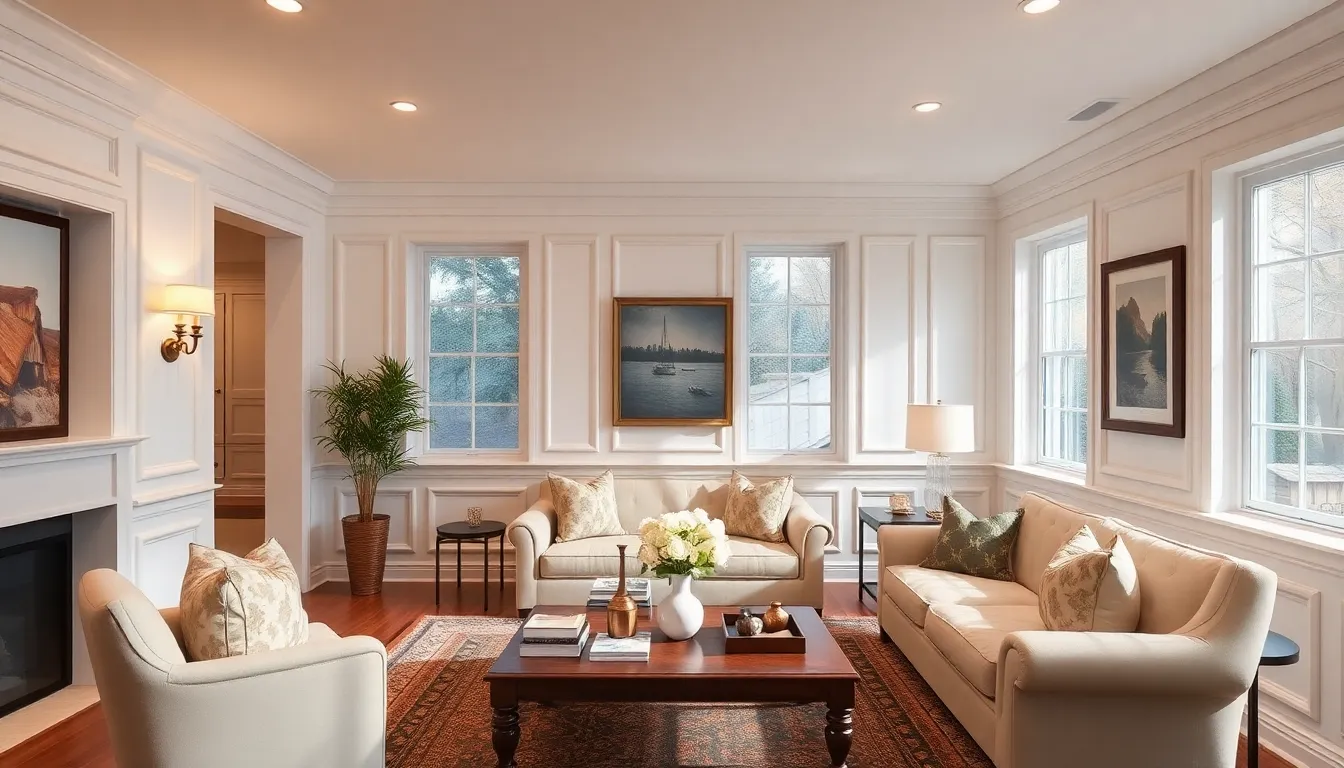
Wainscoting brings architectural character and lasting elegance to any interior space while serving as both decorative and protective wall treatment.
Raised Panel Wainscoting
Traditional raised panel wainscoting delivers formal elegance with its distinctive beveled edges that create visual depth and dimensional interest. We typically install these panels between 30 and 40 inches high, framing them with horizontal rails and vertical stiles for classic proportions. Colonial and traditional homes showcase this style beautifully, where the beveled panel edges catch light and shadow to enhance architectural detail.
Formal dining rooms and hallways benefit most from raised panel installations, where the sophisticated appearance complements elegant furnishings and decor. Cap moldings or cove details often crown the top rail, while the bottom rail can serve as your baseboard or incorporate multiple molding pieces for added complexity.
Flat Panel Wainscoting
Smooth flat panel wainscoting offers clean lines without beveled edges, creating a modern appearance that works in both traditional and contemporary settings. We set these panels behind stiles and top moldings to create the illusion of depth while maintaining simplicity. Installation becomes easier compared to raised panels, making this option attractive for DIY enthusiasts.
Versatile design options emerge when you paint flat panels in contrasting colors or pair them with wallpaper for custom looks. Living rooms, bedrooms, and powder rooms all accommodate this adaptable style well. The smooth surfaces provide perfect canvases for creative color schemes and decorative treatments.
Beadboard Wainscoting
Narrow vertical panels with consistent grooves define beadboard wainscoting, originally popularized in Victorian cottages for casual, informal spaces. We appreciate how the vertical lines add texture and visual interest while making rooms feel cozier and more intimate. Kitchens, bathrooms, and mudrooms commonly feature this approachable style.
Installation flexibility allows full height panels or lower wall treatments depending on your design goals. Combining beadboard with flat or raised panels creates style contrast and enhanced design flexibility throughout your home. The groove patterns catch paint beautifully and hide minor wall imperfections effectively.
Chair Rail Trim Ideas for Mid-Wall Interest
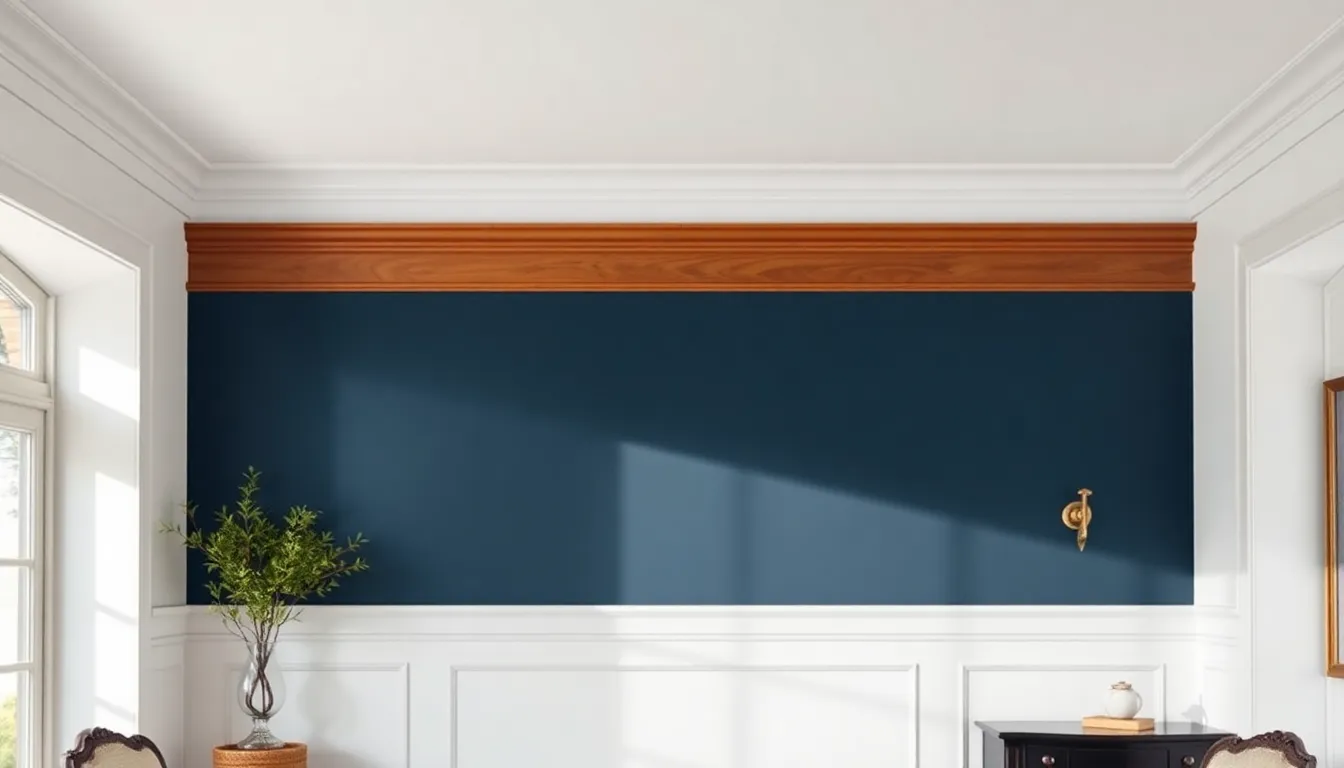
Chair rails bring sophisticated design elements to your walls while breaking up monotonous expanses with purposeful horizontal lines. We’ll explore three distinctive approaches that transform ordinary walls into stunning focal points.
Traditional Wood Chair Rails
Wood chair rails deliver timeless elegance that complements any classic interior design scheme. We recommend positioning these horizontal moldings at one-third of your wall height to create perfect visual proportions. Staining the wood showcases natural grain patterns while painting offers unlimited color coordination with your existing décor.
Classic wood chair rails work exceptionally well in formal dining rooms, hallways, and living spaces where traditional charm takes center stage. You can choose from various wood species like oak, pine, or maple to match your home’s architectural character. These rails create natural breaking points that make tall walls feel more intimate and well-proportioned.
Modern Geometric Chair Rails
Geometric chair rails introduce contemporary flair through clean lines and bold architectural shapes. We love how these modern designs feature sharp angles, stepped profiles, and minimalist details that complement today’s streamlined interiors. Angular chair rail profiles create striking shadow lines that add depth without overwhelming the space.
Contemporary geometric styles work particularly well in modern homes, lofts, and spaces with sleek furnishings. You can experiment with wider profiles or incorporate metal elements for an industrial edge. These modern interpretations maintain the functional benefits of traditional chair rails while delivering fresh visual appeal.
Two-Tone Paint with Chair Rails
Two-tone paint treatments maximize chair rails’ decorative potential by creating dramatic color contrasts above and below the molding. We suggest placing chair rails at the one-third wall height mark to achieve balanced proportions between your color zones. Contrasting colors create visual interest while the chair rail provides a clean transition line.
Popular combinations include navy blue below with crisp white above, or warm gray on the bottom with soft cream on top. You can reverse traditional expectations by using darker colors above the rail for dramatic effect. This technique works brilliantly in bedrooms, dining rooms, and entryways where you want to make a bold design statement.
Baseboard Trim Ideas for Foundation Style
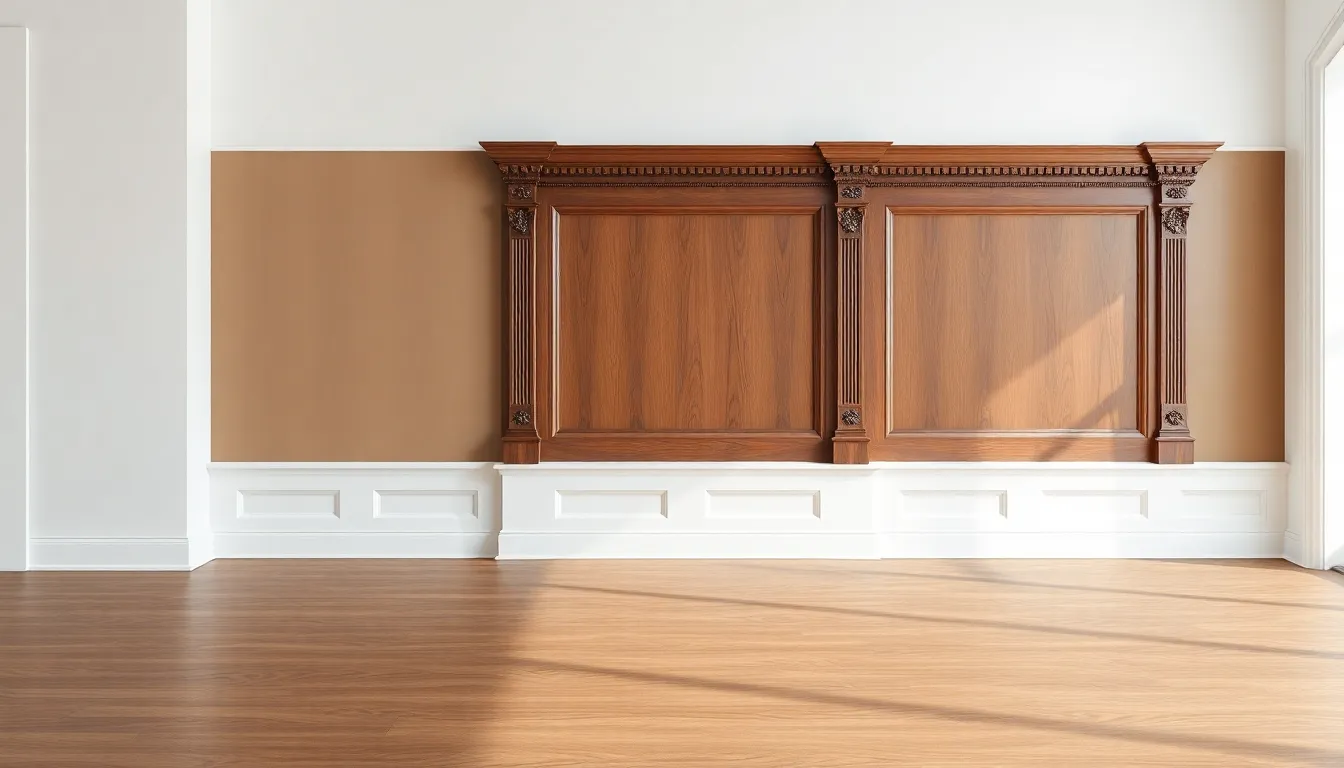
Your room’s foundation style determines which baseboard design will create the most cohesive look. We’ll explore three distinct approaches that can anchor your wall trim project perfectly.
Tall Contemporary Baseboards
Tall contemporary baseboards deliver maximum impact with their minimalist design philosophy. These sleek profiles feature clean lines and minimal curves that complement modern and contemporary spaces beautifully. We recommend heights ranging from 5 to 8 inches for dramatic presence without overwhelming smaller rooms.
Materials like MDF, pine, or composite work exceptionally well for these designs. Custom sizing allows you to match your room’s proportions precisely while maintaining that streamlined aesthetic. Paint them in crisp white or bold accent colors to enhance your contemporary foundation style.
Decorative Victorian Baseboards
Victorian baseboards showcase intricate craftsmanship through elaborate ornamental details. Multiple profiles including ogee, cove, and quarter round styles create rich visual depth that defines traditional and historical interiors. These ornate designs typically measure 6 to 10 inches in height to accommodate their complex layered elements.
Staining brings out the natural wood grain beautifully in formal dining rooms and parlors. Painting in period appropriate colors like deep burgundy or forest green enhances their sophisticated appeal. We’ve found these baseboards work exceptionally well in homes with existing architectural character like crown molding or decorative ceiling medallions.
Minimalist Flat Baseboards
Flat baseboards embrace simplicity with their completely smooth profile design. No curves, bevels, or decorative elements interrupt their clean geometric lines, making them ideal for ultra-modern and minimalist foundation styles. Heights between 3 to 5 inches provide subtle definition without creating visual competition.
Installation proves straightforward since these boards require minimal cutting and fitting compared to complex profiles. We often pair them with matching door casings and window trim for seamless continuity throughout modern homes. Bright white paint creates crisp contrast against colored walls while darker tones blend seamlessly for understated elegance.
Picture Frame Wall Trim Ideas for Architectural Drama
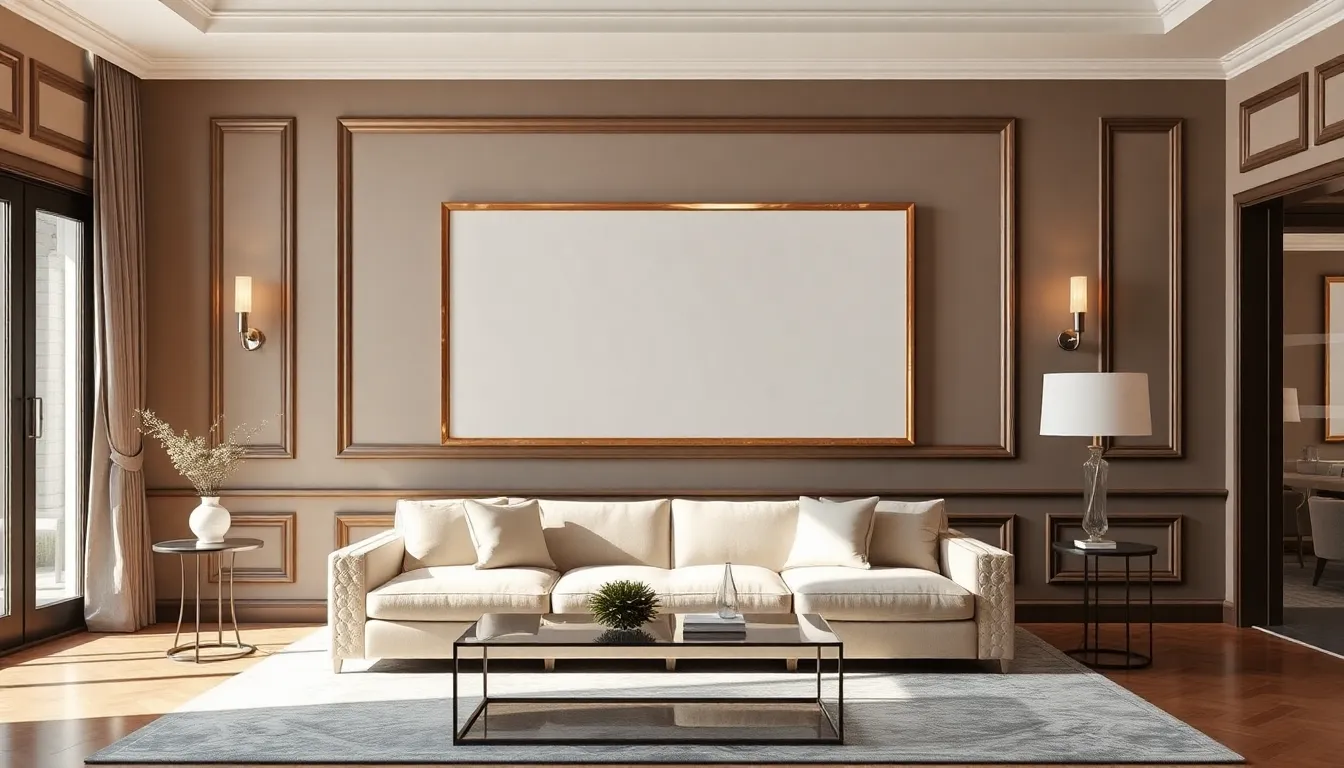
Picture frame wall trim transforms ordinary surfaces into stunning architectural focal points. These dimensional designs create visual interest while maintaining the sophisticated elegance that defines professional interior styling.
Large Rectangle Picture Frames
Large rectangle picture frames make bold statements on expansive wall surfaces, offering instant elegance through their grand proportions. We recommend creating frames that span 36 to 48 inches in width for maximum impact in formal spaces like dining rooms and living areas. These oversized frames work particularly well above furniture pieces such as sofas, beds, or credenzas where they can define the space without overwhelming it.
Molding materials like MDF or wood provide the structural foundation for these impressive frames. We’ve found that using 2-inch to 3-inch wide trim creates the perfect balance between presence and proportion. The installation process requires careful measurements and a miter saw to achieve crisp corner joints that enhance the frame’s professional appearance.
Square Grid Picture Frame Patterns
Square grid picture frame patterns deliver modern sophistication through their uniform geometry and clean lines. We typically design these grids using 18-inch to 24-inch squares, creating a balanced composition that works beautifully in contemporary spaces. These patterns excel in hallways, powder rooms, and accent walls where they add visual texture without competing with furniture.
The grid system allows for creative flexibility in both size and spacing variations. We recommend maintaining consistent gaps of 6 to 12 inches between frames to preserve the pattern’s visual harmony. Polystyrene molding offers an excellent lightweight option for these projects, making installation easier while maintaining durability.
Asymmetrical Picture Frame Designs
Asymmetrical picture frame designs create ever-changing visual effects through intentional irregularity and artistic placement. We combine different frame sizes ranging from 12-inch squares to 36-inch rectangles to establish rhythm and movement across the wall surface. These designs work exceptionally well in creative spaces like home offices, art studios, or modern living areas where conventional symmetry might feel too rigid.
Strategic placement becomes crucial for achieving balance within the asymmetrical composition. We suggest starting with larger frames as anchor points, then filling in with smaller elements to create visual flow. The key lies in maintaining enough white space between frames to prevent the design from appearing cluttered while ensuring each frame contributes to the overall architectural drama.
Board and Batten Wall Trim Ideas for Rustic Charm
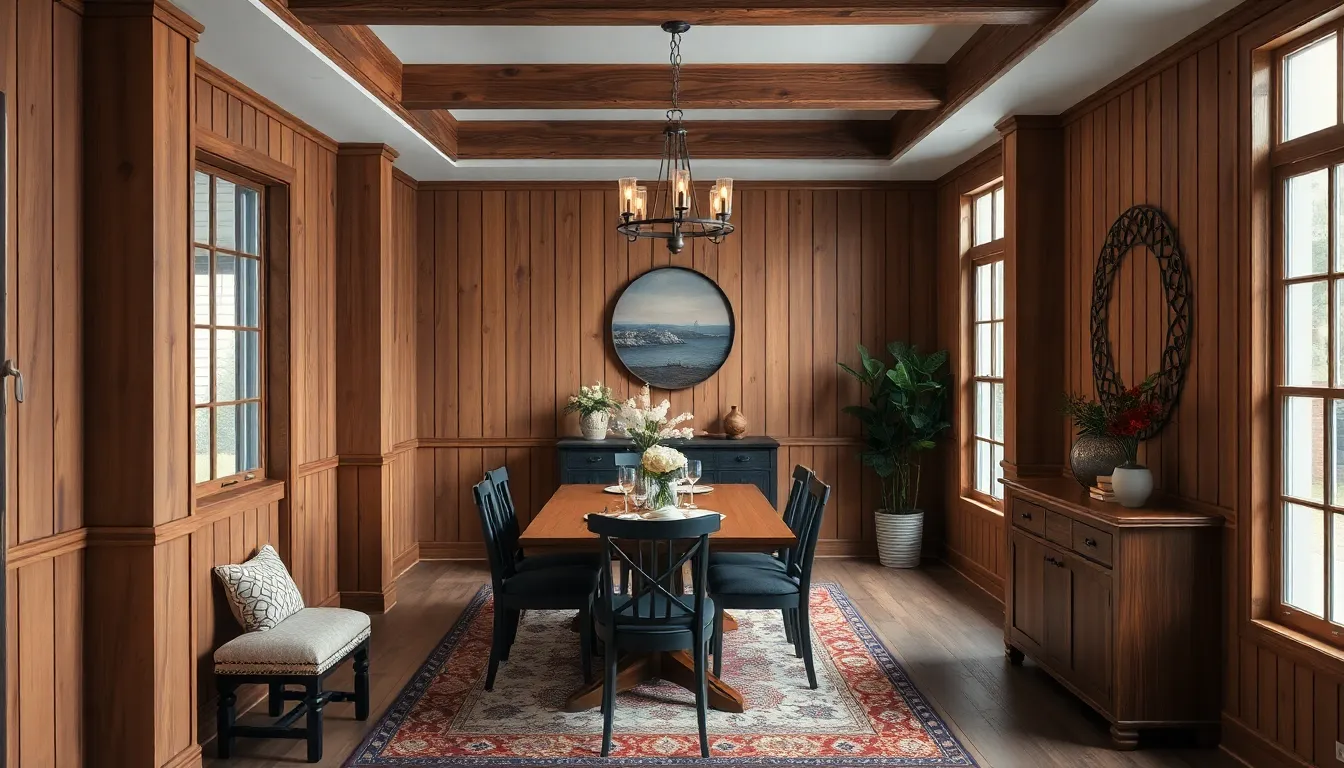
Board and batten wall trim transforms ordinary spaces into cozy retreats with architectural character. This versatile design approach offers multiple styling options that bring warmth and texture to any room.
Vertical Board and Batten
Vertical board and batten delivers the most traditional rustic charm for your wall trim project. We recommend installing this classic style in dining areas and bedrooms where the vertical lines create height and visual interest. The design features vertical wood panels separated by thin battens that add depth and shadow lines to flat walls.
Installation involves using 1×4 or 1×6 primed MDF boards with 1×3 MDF battens for optimal results. You can extend the design from floor to ceiling for maximum impact or install it partway up the wall with chair rail molding for added detail. This approach works especially well in farmhouse and cottage style interiors.
Horizontal Board and Batten
Horizontal board and batten offers a contemporary twist on the traditional vertical design. We’ve seen this modern approach gain popularity in living rooms and kitchens where it creates wide, expansive panel looks. The horizontal orientation makes rooms appear wider and adds a fresh perspective to the classic board and batten style.
This design technique works particularly well in spaces with high ceilings where vertical lines might feel overwhelming. You can combine horizontal boards with different spacing patterns to create unique visual rhythms along your walls. The horizontal approach pairs beautifully with modern farmhouse and transitional design styles.
Mixed Width Board and Batten
Mixed width board and batten creates visually ever-changing designs through varied board dimensions. We recommend this approach for hallways and entryways where the varying widths add movement and interest to narrow spaces. The combination of different board sizes prevents the monotony that can occur with uniform spacing.
Installation typically involves alternating between 1×4 and 1×6 boards with consistent batten spacing for balanced proportions. You can keep the entire project under $300 using budget friendly materials while achieving a custom millwork appearance. This style allows for creative expression while maintaining the rustic charm that makes board and batten so appealing.
Window and Door Casing Trim Ideas for Finished Looks
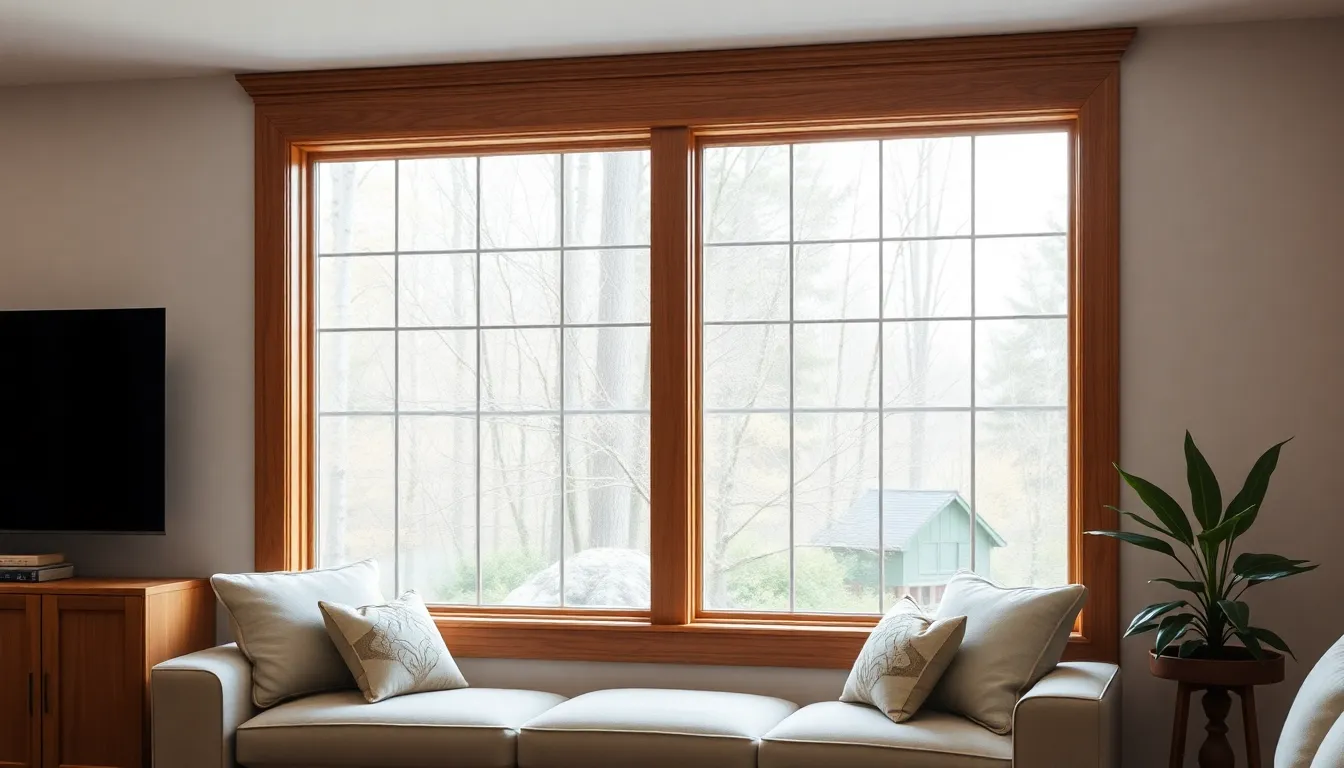
Window and door casings serve as the finishing touch that frames your openings and creates polished transitions between walls and architectural elements. These trim pieces transform basic doorways and windows into focal points while maintaining the cohesive design flow we’ve established with our wall trim projects.
Craftsman Style Window Trim
Craftsman style window trim emphasizes clean lines and balanced proportions that complement the natural materials and comfort-focused aesthetic of this timeless design approach. Oak and other quality woods serve as the preferred materials, creating warmth and authenticity that distinguishes craftsman trim from mass-produced alternatives.
Design flexibility defines craftsman window trim, as no strict dimensional rules govern its installation. Wide headers and aprons paired with thinner side casings create visual interest while maintaining the proportional balance essential to craftsman aesthetics. Room dimensions should guide your trim proportions, ensuring the finished look feels natural rather than overwhelming or undersized.
Natural wood finishes work beautifully with craftsman trim, allowing the grain patterns and wood tones to showcase the material’s inherent beauty. Staining options range from light honey tones to rich walnut shades, each creating different moods while preserving the authentic craftsman character.
Modern Flat Window Casings
Modern flat window casings deliver sleek, minimalist appeal through their streamlined profiles and contemporary material choices. MDF and poplar serve as popular options for these installations, offering paintable surfaces that integrate seamlessly with modern interior designs.
Simplicity drives the modern flat casing approach, eliminating ornate details in favor of clean geometry and precise installation. These trim pieces focus attention on window views rather than decorative elements, creating uncluttered sight lines that enhance contemporary living spaces.
Installation ease makes modern flat casings attractive for DIY enthusiasts, as their straightforward profiles require fewer complex cuts and joints compared to traditional trim styles. Paint finishes in crisp whites, bold colors, or subtle grays allow these casings to either blend invisibly or make deliberate design statements.
Decorative Door Frame Trim
Decorative door frame trim ranges from ornate traditional designs to sophisticated minimalist profiles, each approach improving doorway transitions while reflecting your overall design vision. Wood, MDF, and vinyl materials provide different aesthetic and budget options for achieving your desired decorative impact.
Intricate carvings and molding details characterize ornate decorative trim, creating focal points that announce important room entrances and transitions. These elaborate designs work particularly well in formal spaces like dining rooms and entryways where architectural drama enhances the overall ambiance.
Minimalist decorative profiles offer subtle sophistication through refined proportions and carefully considered dimensions rather than surface ornamentation. Simple profiles can still create important visual impact when properly scaled and finished, proving that decorative doesn’t always mean elaborate.
Color and finish choices dramatically affect decorative door trim impact, with stained options highlighting natural wood beauty while painted finishes allow bold color integration. Bright color treatments can modernize traditional craftsman looks, while classic stains preserve timeless appeal that complements existing decor elements.
Creative Accent Wall Trim Ideas for Unique Style
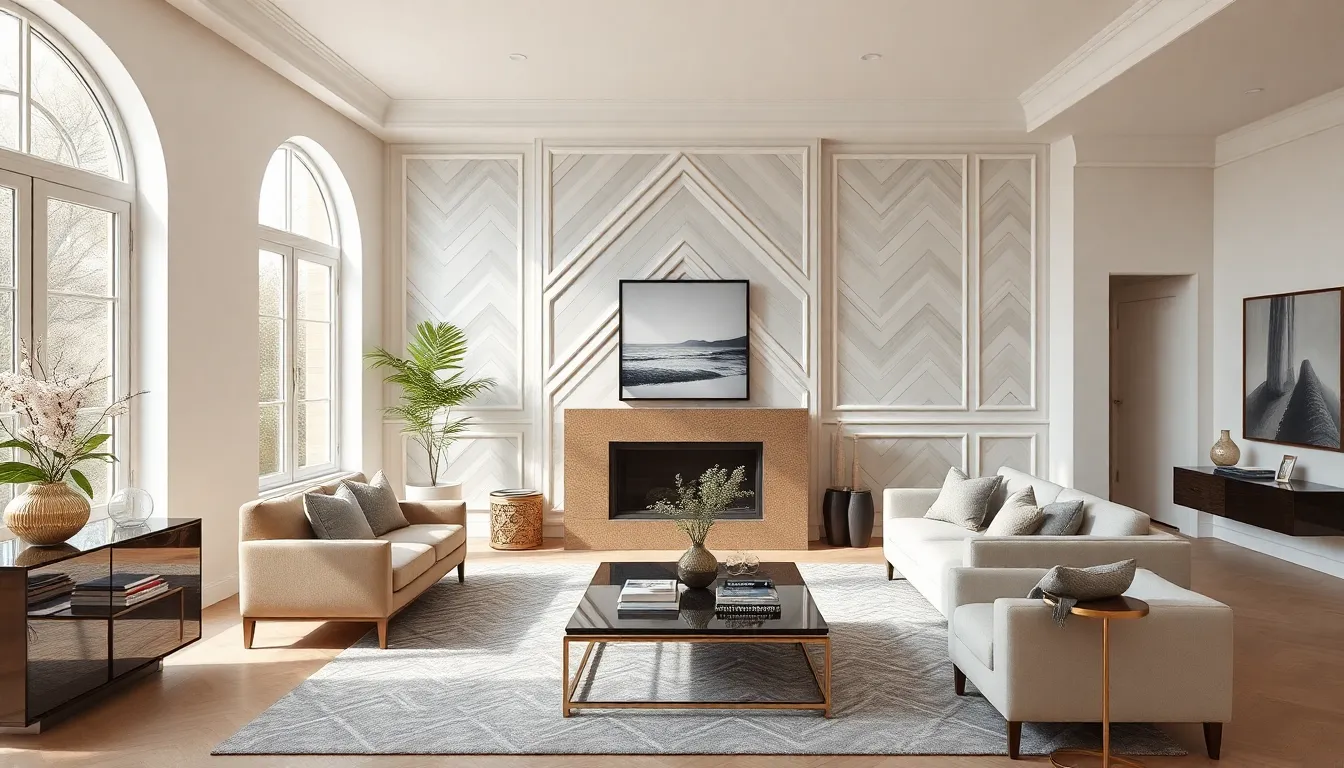
Beyond traditional trim applications, we can transform walls into stunning focal points using innovative design approaches that blend contemporary aesthetics with architectural interest.
Geometric Pattern Wall Trim
Chevron patterns elevate modern spaces with their ever-changing zigzag formations that draw the eye upward and create movement across wall surfaces. Installing trim pieces at 45-degree angles creates this striking chevron effect, which works particularly well in living rooms and bedrooms where you want to make a bold statement.
Herringbone designs achieve sophisticated visual appeal through alternating trim pieces that form intricate V-shaped patterns reminiscent of classic parquet flooring. This technique requires precision cutting and careful planning, but the results deliver a luxurious appearance that’s perfect for accent walls in dining rooms or home offices.
Diamond grid patterns offer geometric interest through interconnected diamond shapes created with intersecting trim pieces. These patterns work exceptionally well in entryways and powder rooms where you want to create immediate visual impact without overwhelming smaller spaces.
Curved and Arched Trim Designs
Arched entries transform ordinary doorways and windows into dramatic architectural features using curved trim that creates elegant transitions between rooms. Professional installation typically delivers the best results for these curved applications, as precise measurements and specialized cutting techniques ensure smooth, flowing lines.
Circular patterns add playful sophistication to accent walls through curved trim arranged in concentric circles or overlapping ring designs. These patterns work beautifully in children’s rooms or creative spaces where you want to introduce organic shapes that soften the angular nature of most architectural elements.
Flowing wave designs incorporate gentle curves that create movement and rhythm across wall surfaces, making rooms feel more ever-changing and visually captivating. Installing flexible trim materials or steam-bent wood allows for these organic curves that work particularly well in contemporary and transitional interior styles.
Mixed Material Trim Combinations
Wood and metal combinations create contemporary sophistication by blending warm wooden trim with sleek metallic accents like brushed steel or aged copper. This approach works exceptionally well in modern kitchens and bathrooms where you want to balance natural warmth with industrial elements.
Textural contrasts emerge when combining smooth painted trim with rough-hewn reclaimed wood or glass panel inserts that reflect light and add depth to wall compositions. These combinations allow for endless customization possibilities while creating unique focal points that reflect personal style preferences.
Color blocking techniques use trim to define distinct painted sections on accent walls, creating bold geometric compositions that serve as artwork in their own right. Strategic placement of contrasting trim colors can visually expand or contract room proportions while adding personality to otherwise neutral spaces.
Budget-Friendly DIY Wall Trim Ideas for Cost-Effective Updates
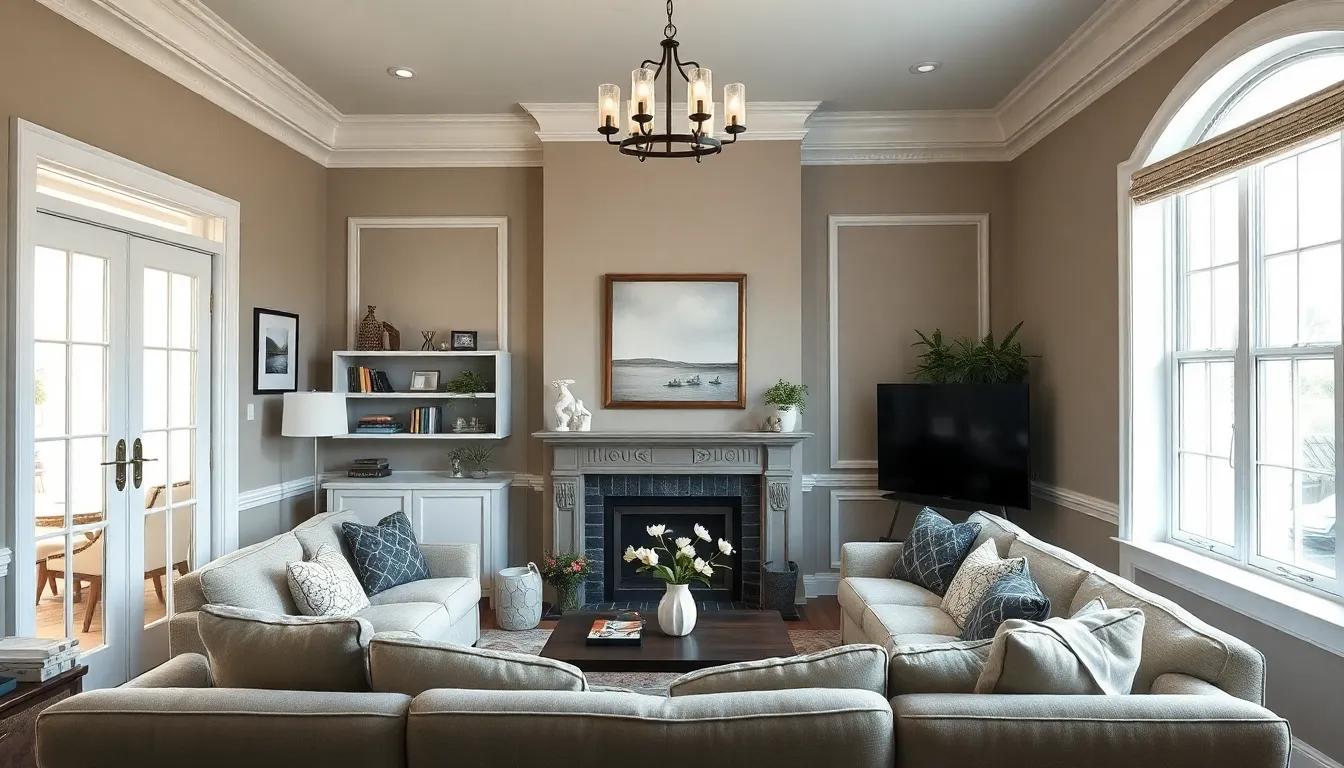
We don’t need expensive materials to achieve stunning wall trim designs that transform our spaces. Creating beautiful trim on a budget opens up endless possibilities for homeowners who want to add architectural interest without very costly.
Foam Board Trim Alternatives
Foam board serves as an excellent budget-friendly alternative to traditional wood trim materials. We can paint foam board to mimic expensive wood finishes while spending a fraction of the cost. This lightweight material cuts easily with basic tools and installs quickly using construction adhesive.
Medium-density fiberboard (MDF) offers another affordable option that’s easier to work with than solid wood. We’ll find MDF trim at most home improvement stores for significantly less than hardwood alternatives. This material accepts paint beautifully and won’t warp or split like natural wood can over time.
Installation becomes simpler with these lightweight alternatives since we don’t need heavy-duty fasteners. Both materials work perfectly for picture frame molding projects that beginners can tackle over a weekend.
Paint-Only Faux Trim Techniques
Painted stripes create the illusion of trim without requiring any physical materials beyond paint and tape. We can use painter’s tape to mark off sections and apply contrasting colors to mimic wainscoting or chair rails. This technique works especially well in rental properties where permanent modifications aren’t allowed.
Faux molding effects emerge when we paint geometric shapes or lines directly onto walls. Drawing inspiration from traditional trim profiles, we can create shadow lines and dimensional effects using different paint sheens. Satin paint for raised areas and flat paint for recessed sections enhance the illusion of depth.
Color blocking with paint allows us to define spaces and create visual trim without any construction. We might paint the lower third of walls in a darker shade to simulate wainscoting or add painted rectangles to mimic picture frame molding.
Repurposed Material Trim Projects
Old doors provide unique trim pieces when we salvage their raised panels or decorative elements. We can cut door sections into smaller pieces to create custom wall medallions or corner accents. These architectural salvage pieces add character that new materials simply can’t replicate.
Wooden crates transform into rustic trim elements when we disassemble them strategically. Using reclaimed pallet wood, we create board and batten effects or horizontal plank walls that bring farmhouse charm to modern spaces. This approach costs significantly less than purchasing new lumber while adding authentic weathered character.
Antique furniture parts offer one-of-a-kind trim features when we repurpose carved elements or turned spindles. We might salvage decorative corbels from old dressers or use furniture legs as architectural columns. These unique pieces create focal points that guests always notice and admire.
Conclusion
Wall trim offers endless possibilities to transform your home’s interior design without very costly. Whether you’re drawn to classic crown molding or bold geometric accent walls we’ve shown you how simple architectural elements can make dramatic differences in any space.
The beauty of wall trim lies in its versatility and accessibility. From luxurious wainscoting to budget-friendly DIY foam board projects there’s an option for every skill level and budget. These design elements don’t just enhance aesthetics—they add genuine value to your property.
We encourage you to start with one room and experiment with the ideas that resonate most with your personal style. Remember that even the smallest trim details can create the polished professional look that elevates your home from ordinary to extraordinary.
Frequently Asked Questions
What is wall trim and why is it important for interior design?
Wall trim refers to decorative molding and architectural elements applied to walls to enhance their appearance. It’s important because it transforms ordinary builder-grade walls into sophisticated, professionally finished spaces. Trim adds character, conceals imperfections, defines spaces, and increases home value while providing a polished look that distinguishes quality interior design.
What are the most popular types of wall trim for modern homes?
The most popular wall trim types include crown molding for ceiling transitions, wainscoting for lower wall protection, chair rails for mid-wall definition, baseboards for floor transitions, and picture frame molding for decorative panels. Board and batten, window casings, and geometric accent trims are also trending choices for contemporary spaces.
How much does wall trim installation typically cost?
Wall trim costs vary widely based on materials and complexity. Budget-friendly options using MDF or foam board can cost $1-3 per linear foot, while premium hardwood trim ranges $5-15 per linear foot. DIY installation saves labor costs, while professional installation adds $2-8 per linear foot depending on project complexity.
Can I install wall trim myself or do I need a professional?
Many wall trim projects are DIY-friendly, especially simple designs like picture frame molding, chair rails, and basic baseboards. You’ll need basic tools like a miter saw, nail gun, and measuring tape. However, complex projects involving crown molding, intricate wainscoting, or curved designs may require professional installation for best results.
What materials work best for different wall trim projects?
MDF is excellent for painted trim projects due to its smooth finish and affordability. Solid wood works best for stained applications and high-traffic areas. Foam board is perfect for budget-friendly decorative trim. PVC trim suits moisture-prone areas like bathrooms. Choose materials based on your budget, style preferences, and room conditions.
How do I choose the right wall trim style for my home?
Consider your home’s architectural style, ceiling height, and existing decor. Traditional homes suit ornate crown molding and raised panel wainscoting. Modern spaces work well with clean lines and geometric patterns. Craftsman styles complement board and batten or picture frame trim. Match trim proportions to room size for balanced aesthetics.
What are some creative accent wall trim ideas?
Creative accent wall trim includes geometric patterns like chevron, herringbone, and diamond grids. Curved and arched designs add dramatic architectural interest. Mixed materials combining wood and metal create contemporary sophistication. Color blocking techniques use contrasting trim colors to create bold geometric compositions and visual focal points.
How can I create wall trim on a tight budget?
Use affordable materials like MDF, foam board, or repurposed items. Try paint-only faux trim techniques creating geometric shapes and stripes without physical materials. Repurpose salvaged doors, wooden crates, or antique furniture parts. Focus on high-impact areas like accent walls rather than entire rooms to maximize visual effect while minimizing costs.
